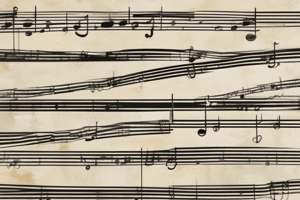Podcast
Questions and Answers
What is melodic dictation, and what does it involve?
What is melodic dictation, and what does it involve?
- Transcribing melodies by ear (correct)
- Transcribing melodies by reading sheet music
- Transcribing melodies using music theory
- Transcribing melodies using technology
What is the first step in practicing melodic dictation?
What is the first step in practicing melodic dictation?
- Identify the key of the melody
- Break down the melody into sections
- Use solfege or scale degrees
- Start with simple melodies (correct)
Why is it important to break down the melody into smaller phrases or sections?
Why is it important to break down the melody into smaller phrases or sections?
- To make it easier to transcribe and memorize (correct)
- To focus on the rhythm
- To make the melody more complicated
- To identify the key of the melody
What is the purpose of analyzing each phrase and identifying intervals between notes?
What is the purpose of analyzing each phrase and identifying intervals between notes?
What is the benefit of singing or playing along with the recording?
What is the benefit of singing or playing along with the recording?
Why is identifying the key or tonality of the melody important?
Why is identifying the key or tonality of the melody important?
What is the purpose of using solfege or scale degrees?
What is the purpose of using solfege or scale degrees?
What is the ultimate goal of melodic dictation?
What is the ultimate goal of melodic dictation?
What is the primary goal of melodic dictation?
What is the primary goal of melodic dictation?
How can one improve melodic dictation skills?
How can one improve melodic dictation skills?
Why is it essential to seek feedback for melodic dictation exercises?
Why is it essential to seek feedback for melodic dictation exercises?
What is harmonic dictation?
What is harmonic dictation?
What is the first step to develop harmonic dictation skills?
What is the first step to develop harmonic dictation skills?
Why is it helpful to break down the music into sections for harmonic dictation?
Why is it helpful to break down the music into sections for harmonic dictation?
How can visualizing the music help with harmonic dictation?
How can visualizing the music help with harmonic dictation?
What can a keyboard instrument help with in harmonic dictation?
What can a keyboard instrument help with in harmonic dictation?
What are harmonic analysis tools used for?
What are harmonic analysis tools used for?
Why is it important to practice melodic dictation regularly?
Why is it important to practice melodic dictation regularly?
What is the main purpose of using tools for harmonic dictation?
What is the main purpose of using tools for harmonic dictation?
What is key to improving harmonic dictation skills?
What is key to improving harmonic dictation skills?
Why is it important to listen to a wide range of musical styles and genres?
Why is it important to listen to a wide range of musical styles and genres?
What is the first step in identifying melodic patterns and motifs?
What is the first step in identifying melodic patterns and motifs?
Why is it important to break down the melody into smaller fragments?
Why is it important to break down the melody into smaller fragments?
What is important to analyze when identifying melodic patterns and motifs?
What is important to analyze when identifying melodic patterns and motifs?
What can variations of melodic patterns and motifs help you develop?
What can variations of melodic patterns and motifs help you develop?
Why is it important to compare different sections of a piece?
Why is it important to compare different sections of a piece?
What is crucial to developing harmonic dictation skills?
What is crucial to developing harmonic dictation skills?
Why is patience important when improving harmonic dictation skills?
Why is patience important when improving harmonic dictation skills?
What is the primary purpose of transcribing a small phrase or motif?
What is the primary purpose of transcribing a small phrase or motif?
What is essential to excel in transcribing melodic variations?
What is essential to excel in transcribing melodic variations?
How can you refine your transcriptions?
How can you refine your transcriptions?
What is the result of regularly practicing transcribing melodic variations?
What is the result of regularly practicing transcribing melodic variations?
Why is it necessary to verify your work by listening to the original piece?
Why is it necessary to verify your work by listening to the original piece?
What is the purpose of applying the transcribed variations?
What is the purpose of applying the transcribed variations?
What is the outcome of actively using the transcribed variations?
What is the outcome of actively using the transcribed variations?
What is the key to becoming more adept at transcribing melodic variations?
What is the key to becoming more adept at transcribing melodic variations?
What is the primary goal of analyzing melodic patterns and motifs?
What is the primary goal of analyzing melodic patterns and motifs?
What technique can help in identifying patterns and motifs in a melody?
What technique can help in identifying patterns and motifs in a melody?
Why is it essential to familiarize yourself with the original melody before transcribing variations?
Why is it essential to familiarize yourself with the original melody before transcribing variations?
What is the benefit of comparing different variations of a melodic pattern?
What is the benefit of comparing different variations of a melodic pattern?
What should you focus on when transcribing melodic variations?
What should you focus on when transcribing melodic variations?
What is the recommended approach to transcribing melodic variations?
What is the recommended approach to transcribing melodic variations?
What is the benefit of incorporating melodic patterns and motifs into your own compositions?
What is the benefit of incorporating melodic patterns and motifs into your own compositions?
What is the primary skill that develops with time and consistent practice in melodic dictation?
What is the primary skill that develops with time and consistent practice in melodic dictation?
Why is it recommended to practice actively listening to music when developing melodic dictation skills?
Why is it recommended to practice actively listening to music when developing melodic dictation skills?
What is the recommended approach to analyzing melodic patterns and motifs?
What is the recommended approach to analyzing melodic patterns and motifs?
Flashcards are hidden until you start studying
Study Notes
Melodic Dictation
- Melodic dictation involves transcribing melodies by ear and helps train the ear to recognize and reproduce melodic patterns.
- Effective exercises for practicing melodic dictation include:
- Starting with simple melodies and breaking them down into smaller phrases or sections.
- Identifying intervals between notes and using solfege or scale degrees to recognize and reproduce specific intervals and patterns.
- Singing or playing along with recordings to develop the ability to reproduce the melody accurately.
- Identifying the key or tonality of the melody before attempting to transcribe it.
- Practicing with a variety of melodies and musical styles to enhance ear training abilities.
Harmonic Dictation
- Harmonic dictation involves transcribing musical chords and progressions by ear.
- Effective strategies and exercises for improving harmonic dictation skills include:
- Starting with simple melodies and identifying the underlying chords.
- Singing and playing along with recordings to develop the ability to hear and recognize harmonic relationships.
- Breaking down music into smaller sections to identify chords and progressions.
- Visualizing the music to enhance understanding of harmonic relationships.
- Practicing with a keyboard instrument to associate the sound of each chord with its corresponding notation.
Identifying Melodic Patterns and Motifs
- Identifying melodic patterns and motifs is essential for any musician, particularly those interested in advanced melodic dictation techniques.
- Effective strategies and techniques for identifying melodic patterns and motifs include:
- Listening actively to the music and distinguishing between the main melodic line and accompanying melodies or harmonic elements.
- Breaking down the melody into smaller fragments and analyzing intervals between consecutive notes.
- Identifying rhythmic patterns and variations throughout the piece.
- Comparing different sections of the music to identify recurring melodic patterns and motifs.
- Utilizing visualization techniques to reveal patterns that may not be obvious from just listening.
Transcribing Music
- Transcribing melodic variations can be a challenging but rewarding task for musicians looking to enhance their understanding of music and expand their melodic dictation skills.
- Effective techniques for transcribing melodic variations include:
- Familiarizing oneself with the original melody before diving into transcribing variations.
- Analyzing the melodic variations and identifying changes made to the original melody.
- Comparing different variations to identify recurring patterns and motifs.
- Focusing on key elements that define a variation, such as changes in rhythm or ornamentation.
- Using notation software or manuscript paper to accurately transcribe the variations.
Studying That Suits You
Use AI to generate personalized quizzes and flashcards to suit your learning preferences.




